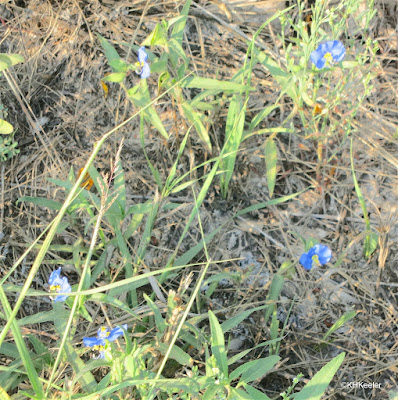 |
| dayflower, Commelina |
The name Commelina was given to these flowers by Linnaeus, in honor of three Dutch botanists. What Linnaeus wrote, actually, was "Commelina has flowers with three petals, two of which are showy, while the third is not conspicuous, from the two botanists name Commelin, for the third died before accomplishing anything in botany."(Stearn p.100.) Who knew Linnaeus had a sense of humor.
 |
| dayflower, Commelina |
 |
| spiderwort, Tradescantia, in the same family as dayflower |
Dayflowers have no nectar for pollinators, only pollen. Each flower is quite ephemeral, open for only a few hours before closing forever. Small bees collect the pollen but the plants probably mostly self-pollinate. But, as you can see in my photos, the flowers are not clustered on the plant, which means a bee collecting pollen has to take flight to find a second flower, which facilitates cross-pollination.
I used to prefer plants that make good cut flowers. Dayflowers rate very low on that list since the few buds on each shoot open several days apart. That means you can't even make a decent flower arrangement by, as with iris, picking a stem with lots of buds which open in subsequent days. That may work out to the plant's advantage, since flowers picked for bouquets never develop any seeds.
Dayflowers are reported as edible, but Deane of Eat the Weeds was not enthusiastic and I do not find them in any of my many books on edible wild plants.
Ah, but they are such a joy when you see them in the grass.
Comments and corrections welcome.
References
Commelina communis L. Asiatic dayflower. Missouri plants. link Accessed 10/17/19.
Deane, G. Commelina diffuse, what a day for a dayflower. Eattheweeds. link Accessed 10/17/19.
Faden, R. B. Commelinaceae R. Brown. Flora of North America link Accessed 9/30/19.
Sanders, J. 1992. Hedgemaids and Fairy Candles. Ragged Mountain Press, Camden Maine.
Stearn, William T. 1996. Stearn's Dictionary of Plant Names for Gardeners. Cassell, London.
Kathy Keeler, A Wandering Botanist
More at awanderingbotanist.com


I love this flower so much. I never seen this flower before. I am happy to see this kind of beautiful flowers. I hope I can buy this flower so I can plant this at home.
ReplyDeleteLovely blog you hhave here
ReplyDelete